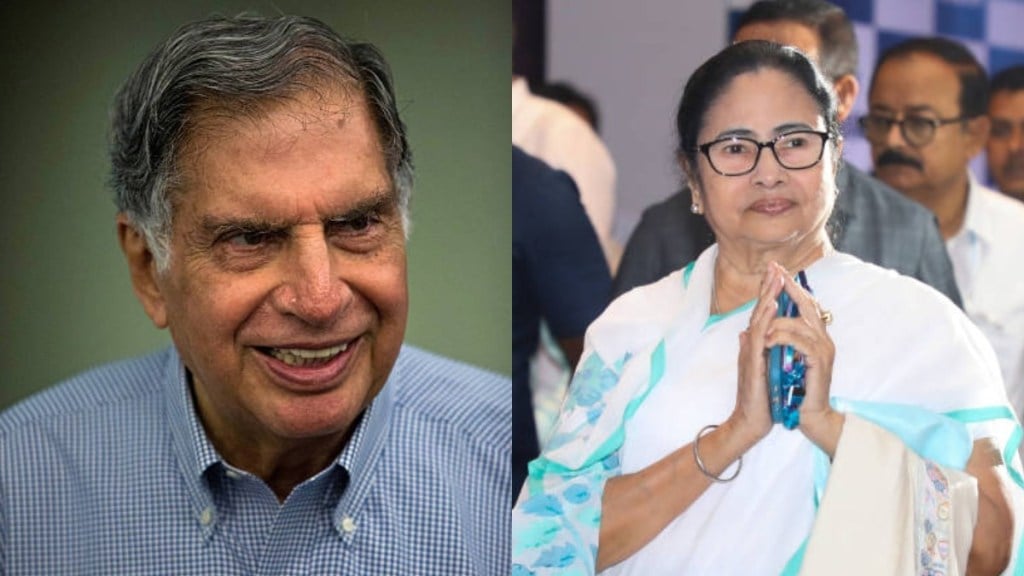West Bengal Chief Minister Mamata Banerjee expressed her sorrow over the death of industrialist Ratan Tata, calling him “a prominent leader of Indian industries and a dedicated philanthropist.”
In a post on X, shared shortly after the 86-year-old’s passing was announced, Banerjee conveyed her grief. She wrote, “Deeply saddened by the passing of Ratan Tata, Chairman Emeritus of Tata Sons. As the former Chairman of the Tata Group, he was a leading figure in Indian industry and a generous philanthropist. His loss is a significant blow to the Indian business community and society at large. I extend my heartfelt condolences to his family and colleagues.”
Tata Nano Controversy and Mamata Banerjee’s Movement in Singur
In October 2008, just as Durga Puja celebrations were beginning, Ratan Tata delivered a shocking announcement to West Bengal: Tata Motors would be pulling out of its nearly completed Nano car plant in Singur, around 30 km north of Kolkata. The decision marked the culmination of a protracted standoff between Tata Motors and Mamata Banerjee’s Trinamool Congress (TMC), which was leading an anti-land acquisition movement.
What Happened at Singur?
Tata Motors had announced its Nano project in 2006, envisioning it as the world’s cheapest car. It was a dream project for Ratan Tata, but it soon encountered fierce opposition. A significant section of Singur’s landowners, whose land had been acquired for the project by the then-Communist Party of India (Marxist) government under Chief Minister Buddhadeb Bhattacharjee, refused to give up their property. The anti-displacement movement, spearheaded by Mamata Banerjee, gained traction, with TMC and civil society groups protesting the land acquisition, demanding that 400 acres of land from the 997-acre site be returned to unwilling farmers.
Despite government efforts to secure the land and continue construction, opposition intensified. Workers faced intimidation, and project boundaries were attacked. Although the plant was nearing completion, the 2008 Panchayat elections, which saw the TMC gaining ground in Singur, reinvigorated the protests. Banerjee stood firm in her demand for returning the land to farmers.
Tata’s Decision to Exit Bengal
Frustrated by the escalating protests and violence, Ratan Tata announced the company’s decision to pull out of Singur. In an uncharacteristically sharp statement, he blamed Mamata Banerjee for derailing the project. “I think Ms Banerjee has pulled the trigger,” he said, referring to the unyielding opposition that forced him to make the “extremely painful” decision.
In an open letter to the people of West Bengal, Tata asked them to choose between industrial growth under Bhattacharjee’s government or a “destructive political environment of confrontation.” The TMC, in response, accused Tata of being politically motivated and supporting the CPI(M) government.
Tata eventually relocated the Nano plant to Sanand, Gujarat, where then-Chief Minister Narendra Modi facilitated the project. Tata even hinted at the contrasting leadership styles between Banerjee and Modi, calling Mamata the “bad M” and Modi the “good M.”
Impact of the Singur Movement
The Singur movement became one of the key factors that fueled Mamata Banerjee’s rise to power. Her anti-land acquisition stance resonated with rural Bengal, and in the 2011 state elections, she ended the Left Front’s three-decade-long rule in West Bengal. The 2009 Lok Sabha elections had already shown the TMC’s growing influence, with the party winning 19 seats compared to just one in 2004.
However, the fallout from Tata’s exit continued to haunt West Bengal’s industrial prospects. Critics argued that the Singur debacle discouraged potential investors, hindering Bengal’s emergence as an industrial hub.
Legal Battles and Compensation
In 2016, after years of legal wrangling, the Supreme Court ruled that the land acquisition for the Nano plant was illegal. It ordered that the land be returned to the original owners. The abandoned factory was razed, and the plots were handed back to the farmers. Despite this, a legal dispute remains over compensation, with Tata Motors demanding damages for their investment.
In 2022, Tata Motors secured an arbitral award of ₹766 crore in compensation for the losses incurred from the scrapped project.
What Happened to the Nano?
The Tata Nano, despite being hailed as an affordable car for the masses, failed to take off in the market. Sales never met expectations, and the model was discontinued in 2019. Various factors were blamed for its failure, from its simple design to delays caused by the political unrest in Bengal.
Ultimately, while the Singur movement cemented Mamata Banerjee’s political standing, the legacy of the Nano project’s failure left a lasting impact on Bengal’s industrial trajectory, illustrating the delicate balance between development and displacement in India’s growth story.

